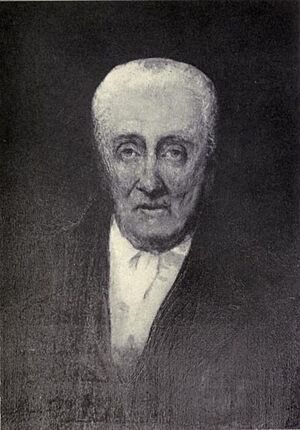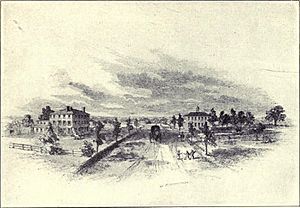Ebenezer Pemberton facts for kids
Quick facts for kids
Ebenezer Pemberton
|
|
|---|---|

Pemberton by William Morris Hunt
|
|
| 2nd Principal of Phillips Academy | |
| In office 1786–1793 |
|
| Preceded by | Eliphalet Pearson |
| Succeeded by | Mark Newman |
| Personal details | |
| Born |
Ebenezer Pemberton
1746 Newport, Colony of Rhode Island and Providence Plantations, British America |
| Died | June 25, 1835 (aged 87–88) Boston, Massachusetts |
| Resting place | Granary Burying Ground |
| Spouse |
Elizabeth Whitwell
(m. 1796) |
| Children | William Whitwell (bp. 1796) Mary Elizabeth Rebecca Royal (bp. 1797) Rebecca Royal (bp. 1797) Eudosia Caroline (bp. 1799) Samuel (bp. 1800) Joanna Eudosia (bp. 1805) |
| Education | Princeton University (1765) |
Ebenezer Pemberton (1746 – June 25, 1835) was an important American educator. He was the second Principal of Phillips Academy in Andover, Massachusetts, from 1786 to 1793. Even though his uncle wanted him to be a clergyman, Pemberton chose to become a teacher. This became his life's work.
After finishing college at Princeton University, he led several schools. These included Plainfield Academy and Phillips Academy. He also started his own schools, like Pemberton Academy in Billerica, Massachusetts. In 1810, he opened another school in Boston. He worked there until he retired due to poor health.
Contents
Early Life and Family Background
Ebenezer Pemberton was born in Newport, Rhode Island, around 1746. His parents were Samuel Pemberton and Mary Frye Leach. He had three siblings:
- Patrick Grant fought in the American Revolutionary War. He was a soldier in the Connecticut Militia.
- Joanna married Captain John Cady. They lived in Plainfield and later Norwich, Connecticut. After her husband died, Joanna moved back to Plainfield. She wanted her two children to get a good education.
- Mary never married and passed away.
After his father died, Ebenezer lived with his uncle, also named Rev. Ebenezer Pemberton. This uncle was a minister in Boston. He also helped start Princeton University. Ebenezer's grandfather, also a Rev. Ebenezer Pemberton, was a minister at the Old South Church in Boston. Because of his uncle's connections, Ebenezer attended Princeton University. He graduated in 1765 as the top student in his class. A newspaper reported that he gave a wonderful speech about patriotism.
Teaching Career and Schools
Early Teaching Roles
After graduating from Princeton, Pemberton taught at a Latin grammar school. This was in Elizabethtown, New Jersey, from 1766 to 1769. Then, for about a year, he returned to Princeton as a tutor. Among his students were famous people like Aaron Burr and James Madison.
Later, he studied theology to become a minister. This was with Rev. Samuel Hopkins in Newport. In 1771, he was asked to teach at Columbia University. He taught alongside other important educators. However, he decided not to become a clergyman, even though his uncle wanted him to. He felt he was not suited for preaching.
Pemberton also tried to become a lawyer in 1777. But he did not like law practice either. This was also a difficult time for Newport. The British had taken over the city in 1776, which hurt its economy.
In 1778, Pemberton moved to Plainfield, Connecticut. His mother lived there. He became the principal of Plainfield Academy. This was a successful school founded in 1770. He did well in Plainfield. His success there caught the attention of Judge Samuel Phillips Jr.. Judge Phillips was the founder of Phillips Academy.
Leading Phillips Academy
Judge Phillips offered Pemberton a job at Phillips Academy. Pemberton first said no because of his health. But he accepted when he was allowed to resign if needed. He became the second Principal in 1786, taking over from Eliphalet Pearson. He earned a salary of £140.
Pemberton was very successful at Phillips Academy. He kept strict rules and managed the school day smoothly. He only used punishment when absolutely necessary. For example, the school's leaders voted on a rule in 1786. It said that if a student used bad language or acted immorally:
- First time: The principal would give a serious warning.
- Second time: Parents would be told.
- Third time: The school's leaders would be informed.
Caleb Strong, who later became the Governor of Massachusetts, was pleased. He wrote to Judge Phillips that his son's manners had greatly improved. Pemberton also made the school's lessons better. He added subjects like geography, advanced math, and public speaking.
Students at Phillips Academy did very well under Pemberton. A total of 77 students graduated and went on to college. Most of them went to Harvard. Religious lessons were also very important. Students read from the Bible and attended church on Sundays.
Judge Phillips was happy with Pemberton's work. He wrote in a letter in 1790 that the Academy was "more flourishing" than before. He noted that the students' behavior was good. John Phillips, who founded Phillips Exeter Academy, also helped Phillips Academy in Andover. He gave over $20,000 to help poor students attend the school.
One of the most exciting events was President George Washington's visit. He came to Phillips Academy on November 5, 1789. This was during his tour of the Eastern States. Washington had breakfast at a local tavern. Then, Judge Phillips escorted him to the Mansion House, where the Judge lived. They had known each other since 1775. That afternoon, President Washington met people informally. This happened on what is now the site of the Memorial Bell Tower.
In 1793, Pemberton said his health was getting worse. He wrote a letter to resign on October 9, 1793. The school leaders delayed his resignation until December 24. They hoped his health would improve. They did not want to lose him. They praised his "ability, attention, and fidelity."
However, his colleagues were surprised by his next move. Despite claiming poor health, he became principal of a school in Billerica, Massachusetts, the next year. Some believed he left Phillips Academy due to personal differences with the Phillips family.
Later Life and Retirement
In 1794, Pemberton moved to Billerica. He started Pemberton Academy there and became its principal. This suggested he was not seriously ill. He completely cut ties with Phillips Academy. His former colleagues were not happy about this. John Phillips, Judge Phillips's son, wrote in a letter in 1796. He felt Pemberton was trying to harm their family and the academy.
While in Billerica, Pemberton also served as a Deacon at the First Church. He remained principal of Pemberton Academy until 1810. That year, he opened a small school in Boston for young children. It was located at 338 Washington Street. Students learned reading, grammar, math, spelling, history, and geography.
Pemberton moved his home several times in Boston. He lived on Newbury Street, Columbia Street, Essex Street, and Hayward Place. His students in Boston also praised him highly. General Henry K. Oliver, one of his former students, described him as a "Christian gentleman." Oliver said Pemberton was dignified, courteous, and pure in thought and life. In 1817, he received an honorary degree from Allegheny College.
Eventually, Pemberton's health truly declined. In 1825, he had to stop being the principal of his Boston school. He handed the responsibility to his two daughters, Mary Elizabeth Rebecca Royal Pemberton and Joanna Evidosia Pemberton. However, he did not stop teaching completely. A writer named Ednah Dow Littlehale Cheney recalled Pemberton teaching her to read in 1830. She said his favorite advice was, "Read slowly, and all other graces will follow."
Pemberton retired without much money. He relied on help from his former students. He passed away on June 25, 1835, in Boston, at 89 years old. He was buried in the Granary Burying Ground.
Legacy and Recognition
Ebenezer Pemberton was praised for his teaching skills. However, he was sometimes criticized for his personality. Claude Fuess, a later headmaster of Phillips Academy, wrote about Pemberton. He said Pemberton did valuable work as Principal. But he was not fully appreciated during his time. His later life ended sadly after a life of sacrifice.
Later in his life, a small portrait of Pemberton was made. This portrait was later given to artist William Morris Hunt. Hunt used it to create a large painting for Phillips Academy. This painting was shown in Boston before being given to the Academy in 1878.
In 1914, a small dormitory at Phillips Academy was named Pemberton Cottage. This was done to honor him. The building was built in 1891 and originally named Taylor Cottage. It is a three-story red brick building. It has white trim and a white porch at its entrance. It can house ten students and a teacher.
Marriage and Children
Pemberton married Elizabeth Whitwell on December 6, 1796, in Boston. She was from Salem. At the time, Pemberton was a principal in Billerica. They had six children, two sons and four daughters:
- William Whitwell (born 1796 – died 1850)
- Mary Elizabeth Rebecca Royal (born 1797) married Rev. Marshall Shedd. She took over her father's school in Boston in 1825. She was known for being very strict and focused on duty.
- Rebecca Royal (born 1797)
- Eudosia Caroline (born 1799) passed away young.
- Samuel (born 1800)
- Joanna Eudosia (born 1805) was born in Billerica. She also helped run her father's school in Boston after 1825. Students found her more friendly than her sister Mary.
Some sources mention fewer children. This might be because they were only counting the children still living at the time of Pemberton's retirement.




